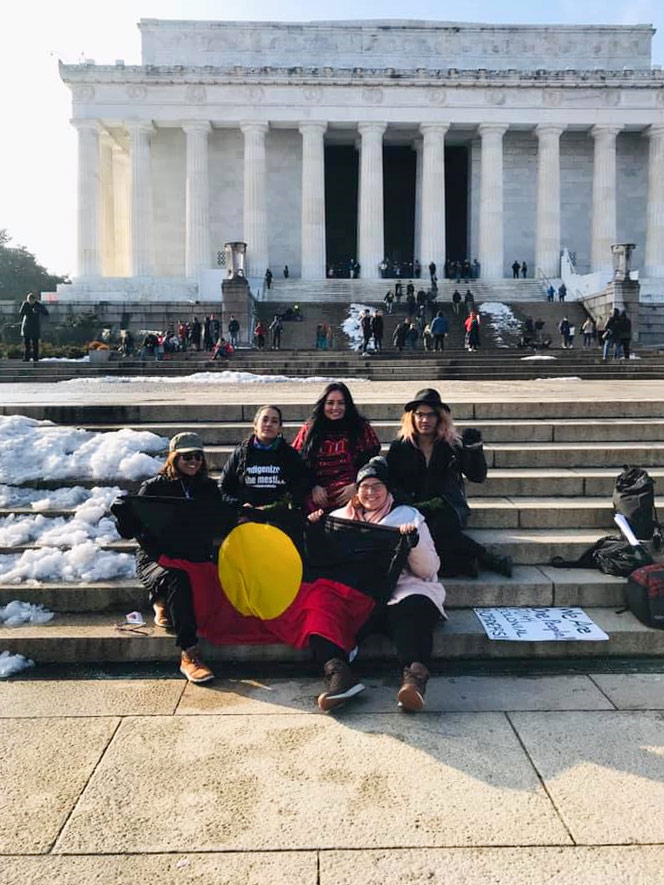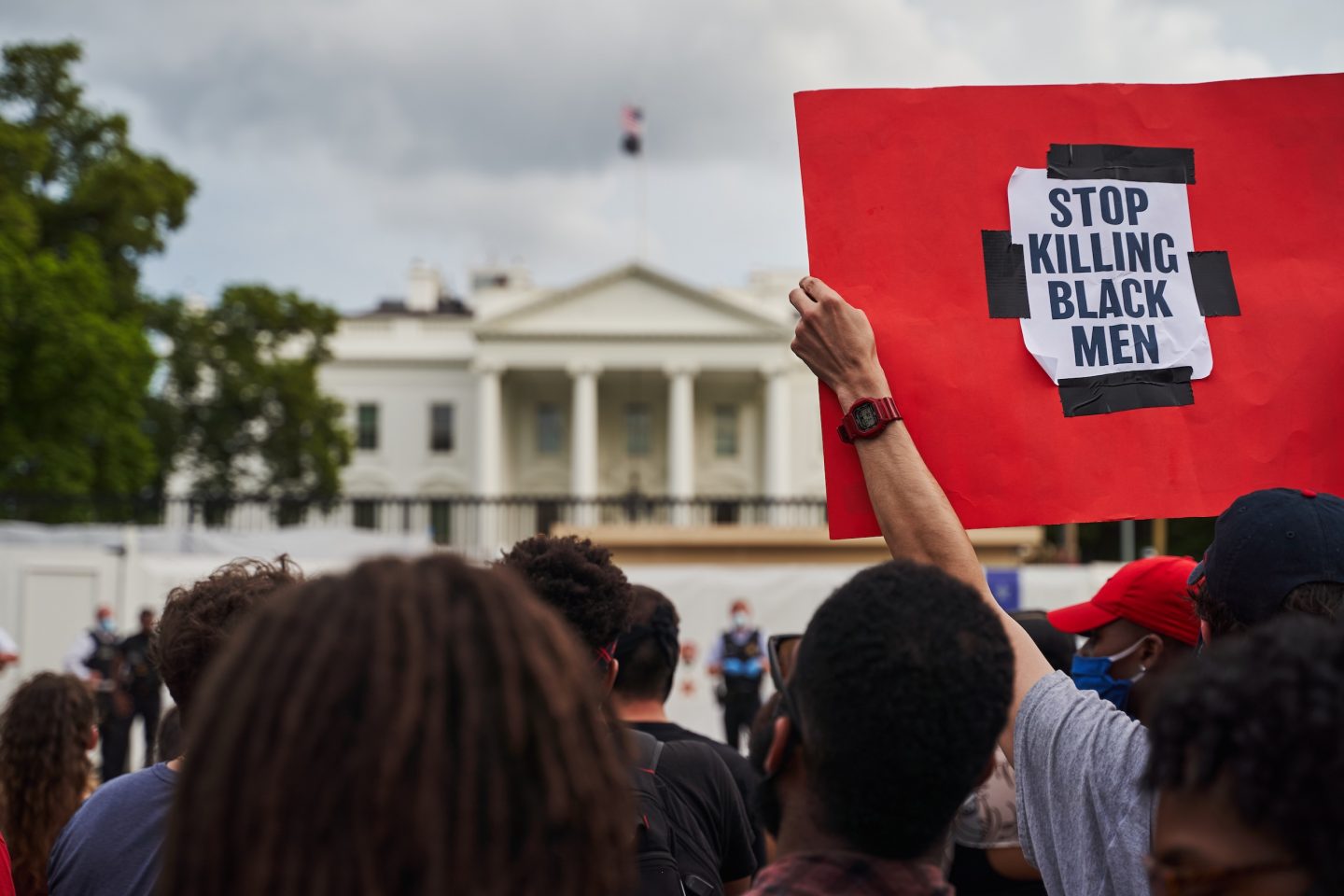“There were thousands of people who showed up at the Lincoln Memorial – we spoke at the same spot Martin Luther King, Jr. gave his ‘I have a dream’ speech, which was a really powerful moment,” Rule tells The Adelaide Review. “I read out a statement speaking about my brother Wayne’s life, and the injustices that we face here as Aboriginal and Torres Strait Islander people.”
Rule had travelled to America to build relationships, share experiences and walk in solidarity with North American First Nations groups and the Black Lives Matter movement, visiting its co-founder Patrisse Cullors in Los Angeles and attending local chapter meetings.
In the past week the killing of 46-year-old George Floyd on 25 May has seen the cumulative result of days, years, centuries of grief and rage spill out onto those same streets, only to be met by yet more official brutality. Watching the protests and police response across Washington DC and other cities has hit home for Rule in more ways than one.
“What we’re seeing in the uprisings at the moment are the feelings, and the pain, that Indigenous and Black peoples have been carrying for so long,” Rule says. “When it gets to this point, that’s the time we start reflecting [on the fact] that we haven’t responded to police and correctional brutality and violence against us in the same way that they have responded to us, and our own identity.
“I think that’s kind of why people are starting to wake up now; they’re realising these shows of pain, and grief, are actually what is needed for us to progress into a space where we’re taken seriously and respected.”
“What we’re seeing in the uprisings at the moment are the feelings, and the pain, that Indigenous and Black peoples have been carrying for so long.”
The aftermath of Floyd’s death under the knee of a Minneapolis police officer has brought renewed attention to the 432 Aboriginal and Torres Strait Islander people who have died in custody since the 1991 Royal Commission. Particular parallels have been drawn to the case of Dunghutti man David Dungay Jr, who died in 2015 while being restrained by prison guards, as he told them repeatedly that he could not breathe.
And to Morrison, a Wiradjuri, Kookatha and Wirangu man who died in September 2016 after being pinned, bound, placed in a spithood and carried away face-down by a dozen corrections officers while on remand at Yatala Labour Prison. Morrison’s death is the subject of an ongoing coronial inquest, but like Floyd the existence – and hard-won release – of CCTV footage of his treatment presents a rare and confronting illustration of the reality of these deaths.
“But we will never see what happened in the final moments that my brother was alive, because of the lack of surveillance, and that’s another thing we have to focus on – how we’re capturing that footage,” Rule says of the growing importance of video footage. “If George Floyd’s death wasn’t recorded it wouldn’t have been an issue; there’s something there about seeing injustice, about seeing oppression and seeing racism that causes people to think what they can do about it, and see how they can respond. Even with the way that Wayne was restrained, if that was not seen I don’t even know if we’d be sitting here having this conversation today.”
Despite such comparisons, there has been a familiar cognitive dissonance on display in the Australian reaction to Floyd’s death and its aftermath. There was Today Show correspondent Alexis Daish telling an African American protestor that “people in Australia don’t have the understanding of the history of police killings and things here”. We’ve heard Prime Minister Scott Morrison warning against “importing” the “divisions” seen overseas ahead of local demonstrations. Closer to home, we’ve seen a former deputy premier and police minister – who once espoused a “rack ’em, pack ’em, stack ’em” approach to South Australian prisons – rubbish comparisons of Australian policing to the Floyd situation online. Such distinctions have rarely held water for families like Rule’s, and their supporters.
 Latoya Aroha Rule (centre front) in Washington DC last year
Latoya Aroha Rule (centre front) in Washington DC last year

Jackson Fox-Bland / Shutterstock
“Injustices against Aboriginal people aren’t seen as important as injustices against other peoples across the globe, who are seen more legitimately when we experience lots of the same issues,” they say.
“The way we’ve come out, and the way we’ve responded has stayed true to how Indigenous peoples have responded since time immemorial – with peace. But peace isn’t being heard, and that grief and pain needs to be felt. So I think when we’re trying to express our pain, when we’re trying to express our feelings of injustice, sometimes this is the only way that we can express them: by taking to the streets and purposely making ourselves become visible in the eyes of those who would rather not see us.
“Australia has a history of 230+ years of ‘invisibilising’ Aboriginal peoples’ pain and trauma,” they say. “Because again, it’s not humanely felt; we have a history of being treated inhumanely, and that’s seen throughout Aboriginal deaths in custody.”
Meanwhile, the flood of black Instagram squares and #BlackLivesMatter solidarity from the Australian public has frustrated some First Nations commentators, observing a level of outrage and solidarity rarely seen for injustices closer to home. As Darumbal/South Sea writer and academic Amy McQuire wrote this week, such displays feel “shallow and performative”. While demonstrations for Rule’s brother, and subsequent cases including the 2019 shooting of 19-year-old Warlpiri man Kumanjayi Walker have attracted thousands of attendees around the country, the scale of this week’s response has been remarkably broad.
“Right now we’re seeing in the last few days at least 7,000 people respond to the Adelaide protest rally, we’re seeing tens of thousands respond in Sydney, Brisbane and Melbourne,” Rule reflects. As of Friday morning, the Adelaide rally planned for Saturday has seen 12,000 people register their interest online.
“While we stand in full solidarity with George Floyd’s family, and numerous Black and Indigenous people in America who have lost their lives due to systemic violence and brutality by corrections and police, over in Australia it’s not adequate for us to march in solidarity globally, with other people in other countries, and then on Sunday after the protest wake up and go back to business as usual,” Rule says. “That’s what I’m scared is going to happen.”
Despite this, and the immense, inter-generational burden that First Nations communities continue to bear decade after decade, Rule remains committed to the importance of protest, as an act of resistance and community-based anti-racism.
“It’s not adequate for us to march in solidarity globally, with other people in other countries, and then on Sunday after the protest wake up and go back to business as usual.”
“I think that there’s two things that protests do, and one doesn’t negate the other, one isn’t better than the other,” they say. “The first is calling out those in power, for legislative change, for real and structural change and transformation. That’s really important, to call out governments.
“It wakes people up in a lot of ways, so even if governments haven’t changed for the last 230+ years, we definitely understand that the power of our love and our own communities does affect other non-Indigenous communities to transform themselves, their own lives and their own behaviours. That’s where some of the best work, the most revolutionary work is actually done.
“So when I look at the ongoing intergenerational response of families like Tanya Day’s, like Ms Dhu’s family – who have lost five people to deaths in custody – and I think about my family, I really do hope that my nieces and nephews aren’t protesting mine or my siblings, or their cousins deaths in the future,” they say, pausing for a moment. “I don’t know if that will be the case or not. But I can only imagine that the more we protest, the more resistance we create, the more change we hope for, it will be received even on a small level.
“If we were meant to die out,” Rule says, invoking the discredited ‘dying race’ theories that informed decades of assimilationist policy, “then our very existence, our providing love and care for each other, is already revolutionary.”
Adelaide’s Solidarity with Minneapolis! Justice for George Floyd rally will be held at Tarntanyangga/Victoria Square on Saturday 6 June from 12pm. Organisers recommend the use of personal face masks and observance of COVID-19 social distance protocols.
Note: An edited version of this story appeared in issue #485 of The Adelaide Review under the title Why They March
Donate:
Walter is a writer and editor living on Kaurna Country.
Get the latest from The Adelaide Review in your inbox
Get the latest from The Adelaide Review in your inbox